如果需要处理的原图及代码,请移步小编的GitHub地址
传送门:请点击我
如果点击有误:https://github.com/LeBron-Jian/ComputerVisionPractice
下面准备学习如何对文档扫描摆正及其OCR识别的案例,主要想法是对一张不规则的文档进行矫正,然后通过tesseract进行OCR文字识别,最后返回结果。下面进入正文:
现代生活中,手机像素比较高,所以大家拍这些照片都很随意,随便拍,比如下面的照片,如发票,文本等等:
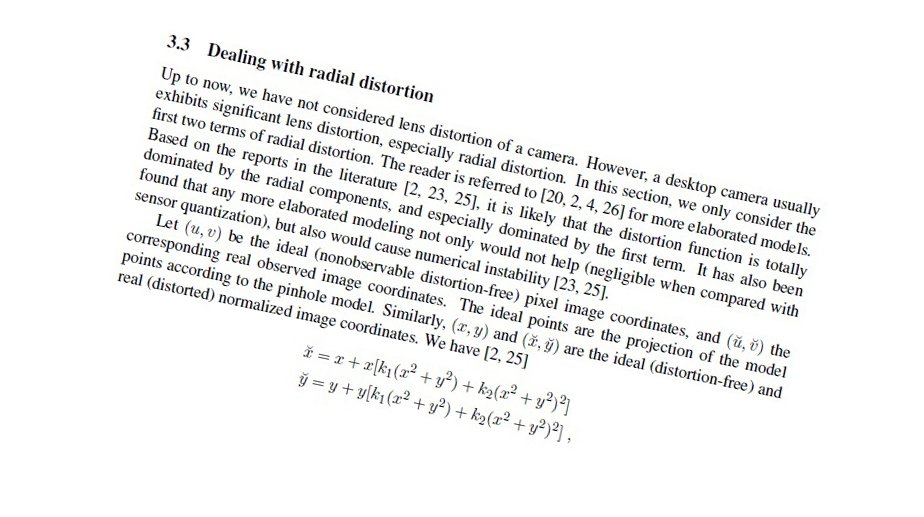
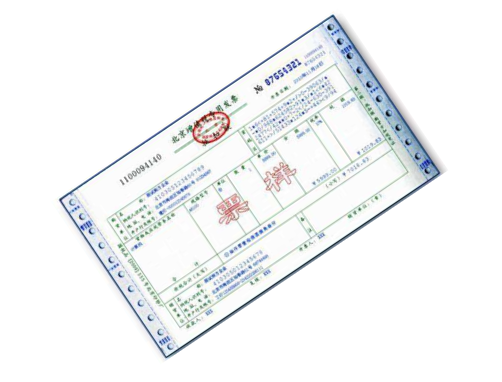
对于这些图像矫正的问题,在图像处理领域还真的很多,比如文本的矫正,车牌的矫正,身份证的矫正等等。这些都是因为拍摄者拍照随意,这就要求我们通过后期的图像处理技术将图片还原好,才能进行下一步处理,比如数字分割,数字识别,字母识别,文字识别等等。
上面的问题,我们在日常生活中遇到的可不少,因为拍摄时拍的不好,导致拍出来的图片歪歪扭扭的,很不自然,那么我们如何将图片矫正过来呢?
总的来说,要进行图像矫正,至少需要以下几步:
- 1,文档的轮廓提取技术
- 2,原始与变换坐标的计算
- 3,通过透视变换获取目标区域
本文通过两个案例,一个是菜单矫正及OCR识别;另一个是答题卡矫正及OCR识别。
项目实战1——文档扫描OCR识别
下面以菜单为例,慢慢剖析如何实现图像矫正,并获取菜单内容。

上面的斜着的菜单,如何扫描到如右图所示的照片呢?其实步骤有以下几步:
- 1,探测边缘
- 2,提取菜单矩阵轮廓四点进行透视变换
- 3,应用一个透视的转换去获取一个文档的自顶向下的正图
知道步骤后,我们开始做吧!
1.1,文档轮廓提取
我们拿到图像之后,首先进行边缘检测,其中预处理包括对噪音进行高斯模糊,然后进行边缘检测(这里采用了Canny算子提取特征),下面我们可以看一下边缘检测的代码与结果:
代码:
def edge_detection(img_path):
# 读取输入
img = cv2.imread(img_path)
# 坐标也会相同变换
ratio = img.shape[0] / 500.0
orig = img.copy()
image = resize(orig, height=500)
# 预处理
gray = cv2.cvtColor(image, cv2.COLOR_BGR2GRAY)
blur = cv2.GaussianBlur(gray, (5, 5), 0)
edged = cv2.Canny(blur, 75, 200)
show(edged)
效果如下:

我们从上图可以看到,已经将菜单的所有轮廓都检测出来了,而我们其实只需要最外面的轮廓,下面我们通过过滤得到最边缘的轮廓即可。
代码如下:
def edge_detection(img_path):
# ********* 预处理 ****************
# 读取输入
img = cv2.imread(img_path)
# 坐标也会相同变换
ratio = img.shape[0] / 500.0
orig = img.copy()
image = resize(orig, height=500)
# 预处理
gray = cv2.cvtColor(image, cv2.COLOR_BGR2GRAY)
blur = cv2.GaussianBlur(gray, (5, 5), 0)
edged = cv2.Canny(blur, 75, 200)
# ************* 轮廓检测 ****************
# 轮廓检测
contours, hierarchy = cv2.findContours(edged.copy(), cv2.RETR_LIST, cv2.CHAIN_APPROX_SIMPLE)
cnts = sorted(contours, key=cv2.contourArea, reverse=True)[:5]
# 遍历轮廓
for c in cnts:
# 计算轮廓近似
peri = cv2.arcLength(c, True)
# c表示输入的点集,epsilon表示从原始轮廓到近似轮廓的最大距离,它是一个准确度参数
approx = cv2.approxPolyDP(c, 0.02*peri, True)
# 4个点的时候就拿出来
if len(approx) == 4:
screenCnt = approx
break
res = cv2.drawContours(image, [screenCnt], -1, (0, 255, 0), 2)
show(res)
效果如下:
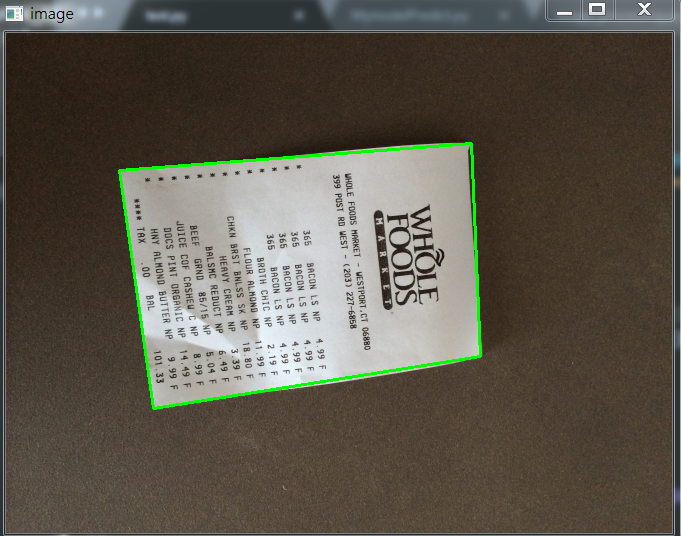
如果说对轮廓排序后,不进行近似的话,我们直接取最大的轮廓,效果图如下:

1.2,透视变换(摆正图像)
当获取到图片的最外轮廓后,接下来,我们需要摆正图像,在摆正图形之前,我们需要先学习透视变换。
1.2.1,cv2.getPerspectiveTransform()
透视变换(Perspective Transformation)是将成像投影到一个新的视平面(Viewing Plane),也称作投影映射(Projective mapping),如下图所示,通过透视变换ABC变换到A'B'C'。
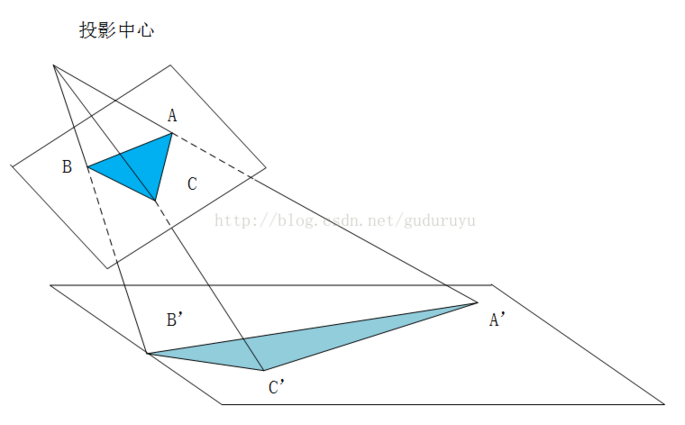
cv2.getPerspectiveTransform() 获取投射变换后的H矩阵。
cv2.getPerspectiveTransform() 函数的opencv 源码如下:
def getPerspectiveTransform(src, dst, solveMethod=None): # real signature unknown; restored from __doc__
"""
getPerspectiveTransform(src, dst[, solveMethod]) -> retval
. @brief Calculates a perspective transform from four pairs of the corresponding points.
.
. The function calculates the f$3 imes 3f$ matrix of a perspective transform so that:
.
. f[egin{bmatrix} t_i x'_i \ t_i y'_i \ t_i end{bmatrix} = exttt{map_matrix} cdot egin{bmatrix} x_i \ y_i \ 1 end{bmatrix}f]
.
. where
.
. f[dst(i)=(x'_i,y'_i), src(i)=(x_i, y_i), i=0,1,2,3f]
.
. @param src Coordinates of quadrangle vertices in the source image.
. @param dst Coordinates of the corresponding quadrangle vertices in the destination image.
. @param solveMethod method passed to cv::solve (#DecompTypes)
.
. @sa findHomography, warpPerspective, perspectiveTransform
"""
pass
参数说明:
- rect(即函数中src)表示待测矩阵的左上,右上,右下,左下四点坐标
- transform_axes(即函数中dst)表示变换后四个角的坐标,即目标图像中矩阵的坐标
返回值由原图像中矩阵到目标图像矩阵变换的矩阵,得到矩阵接下来则通过矩阵来获得变换后的图像,下面我们学习第二个函数。
1.2.2,cv2.warpPerspective()
cv2.warpPerspective() 根据H获得变换后的图像。
opencv源码如下:
def warpPerspective(src, M, dsize, dst=None, flags=None, borderMode=None, borderValue=None): # real signature unknown; restored from __doc__
"""
warpPerspective(src, M, dsize[, dst[, flags[, borderMode[, borderValue]]]]) -> dst
. @brief Applies a perspective transformation to an image.
.
. The function warpPerspective transforms the source image using the specified matrix:
.
. f[ exttt{dst} (x,y) = exttt{src} left ( frac{M_{11} x + M_{12} y + M_{13}}{M_{31} x + M_{32} y + M_{33}} ,
. frac{M_{21} x + M_{22} y + M_{23}}{M_{31} x + M_{32} y + M_{33}}
ight )f]
.
. when the flag #WARP_INVERSE_MAP is set. Otherwise, the transformation is first inverted with invert
. and then put in the formula above instead of M. The function cannot operate in-place.
.
. @param src input image.
. @param dst output image that has the size dsize and the same type as src .
. @param M f$3 imes 3f$ transformation matrix.
. @param dsize size of the output image.
. @param flags combination of interpolation methods (#INTER_LINEAR or #INTER_NEAREST) and the
. optional flag #WARP_INVERSE_MAP, that sets M as the inverse transformation (
. f$ exttt{dst}
ightarrow exttt{src}f$ ).
. @param borderMode pixel extrapolation method (#BORDER_CONSTANT or #BORDER_REPLICATE).
. @param borderValue value used in case of a constant border; by default, it equals 0.
.
. @sa warpAffine, resize, remap, getRectSubPix, perspectiveTransform
"""
pass
参数说明:
- src 表示输入的灰度图像
- M 表示变换矩阵
- dsize 表示目标图像的shape,(width, height)表示变换后的图像大小
- flags:插值方式,interpolation方法INTER_LINEAR或者INTER_NEAREST
- borderMode:边界补偿方式,BORDER_CONSTANT or BORDER_REPLCATE
- borderValue:边界补偿大小,常值,默认为0
1.2.3 cv2.perspectiveTransform()
cv2.perspectiveTransform() 和 cv2.warpPerspective()大致作用相同,但是区别在于 cv2.warpPerspective()适用于图像,而cv2.perspectiveTransform() 适用于一组点。
cv2.perspectiveTransform() 的opencv源码如下:
def perspectiveTransform(src, m, dst=None): # real signature unknown; restored from __doc__
"""
perspectiveTransform(src, m[, dst]) -> dst
. @brief Performs the perspective matrix transformation of vectors.
.
. The function cv::perspectiveTransform transforms every element of src by
. treating it as a 2D or 3D vector, in the following way:
. f[(x, y, z)
ightarrow (x'/w, y'/w, z'/w)f]
. where
. f[(x', y', z', w') = exttt{mat} cdot egin{bmatrix} x & y & z & 1 end{bmatrix}f]
. and
. f[w = fork{w'}{if (w'
e 0)}{infty}{otherwise}f]
.
. Here a 3D vector transformation is shown. In case of a 2D vector
. transformation, the z component is omitted.
.
. @note The function transforms a sparse set of 2D or 3D vectors. If you
. want to transform an image using perspective transformation, use
. warpPerspective . If you have an inverse problem, that is, you want to
. compute the most probable perspective transformation out of several
. pairs of corresponding points, you can use getPerspectiveTransform or
. findHomography .
. @param src input two-channel or three-channel floating-point array; each
. element is a 2D/3D vector to be transformed.
. @param dst output array of the same size and type as src.
. @param m 3x3 or 4x4 floating-point transformation matrix.
. @sa transform, warpPerspective, getPerspectiveTransform, findHomography
"""
pass
参数含义:
- src:输入的二通道或三通道的图像
- m:变换矩阵
- 返回结果为相同size的图像
1.2.4 摆正图像
将图像框出来后,我们计算出变换前后的四个点的坐标,然后得到最终的变换结果。
代码如下:
def order_points(pts):
# 一共四个坐标点
rect = np.zeros((4, 2), dtype='float32')
# 按顺序找到对应的坐标0123 分别是左上,右上,右下,左下
# 计算左上,由下
# numpy.argmax(array, axis) 用于返回一个numpy数组中最大值的索引值
s = pts.sum(axis=1) # [2815.2 1224. 2555.712 3902.112]
print(s)
rect[0] = pts[np.argmin(s)]
rect[2] = pts[np.argmax(s)]
# 计算右上和左
# np.diff() 沿着指定轴计算第N维的离散差值 后者-前者
diff = np.diff(pts, axis=1)
rect[1] = pts[np.argmin(diff)]
rect[3] = pts[np.argmax(diff)]
return rect
# 透视变换
def four_point_transform(image, pts):
# 获取输入坐标点
rect = order_points(pts)
(tl, tr, br, bl) = rect
# 计算输入的w和h的值
widthA = np.sqrt(((br[0] - bl[0])**2) + ((br[1] - bl[1])**2))
widthB = np.sqrt(((tr[0] - tl[0])**2) + ((tr[1] - tl[1])**2))
maxWidth = max(int(widthA), int(widthB))
heightA = np.sqrt(((tr[0] - br[0])**2) + ((tr[1] - br[1])**2))
heightB = np.sqrt(((tl[0] - bl[0])**2) + ((tl[1] - bl[1])**2))
maxHeight = max(int(heightA), int(heightB))
# 变化后对应坐标位置
dst = np.array([
[0, 0],
[maxWidth - 1, 0],
[maxWidth - 1, maxHeight - 1],
[0, maxHeight - 1]],
dtype='float32')
# 计算变换矩阵
M = cv2.getPerspectiveTransform(rect, dst)
warped = cv2.warpPerspective(image, M, (maxWidth, maxHeight))
# 返回变换后的结果
return warped
# 对透视变换结果进行处理
def get_image_processingResult():
img_path = 'images/receipt.jpg'
orig, ratio, screenCnt = edge_detection(img_path)
# screenCnt 为四个顶点的坐标值,但是我们这里需要将图像还原,即乘以以前的比率
# 透视变换 这里我们需要将变换后的点还原到原始坐标里面
warped = four_point_transform(orig, screenCnt.reshape(4, 2)*ratio)
# 二值处理
gray = cv2.cvtColor(warped, cv2.COLOR_BGR2GRAY)
thresh = cv2.threshold(gray, 100, 255, cv2.THRESH_BINARY)[1]
thresh_resize = resize(thresh, height = 400)
show(thresh_resize)
效果如下:
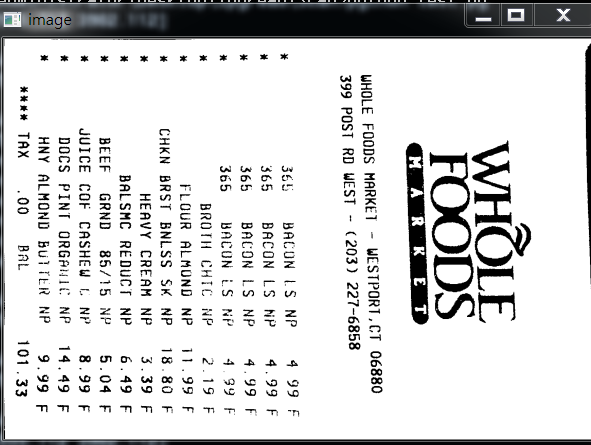
1.2.5 其他图片矫正实践
这里图片原图都可以去我的GitHub里面去拿(地址:https://github.com/LeBron-Jian/ComputerVisionPractice)。
对于下面这张图:
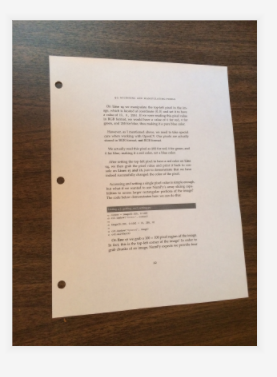
我们使用透视变换抠出来效果如下:
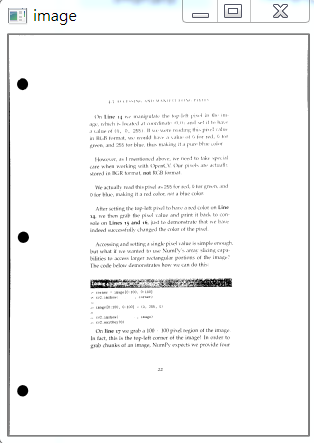
这个图使用和之前的代码就可以,不用修改任何东西就可以拿到其目标区域。
下面看这张图:
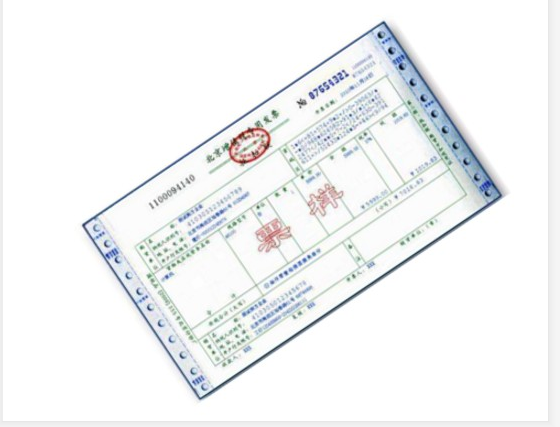
其实和上面图类似,不过这里我们依次看一下其图像处理过程,毕竟和上面两张图完全不是一个类型了。
首先是 Canny算子得到的结果:

其实拿到全轮廓后,我们就直接获取最外面的轮廓即可。
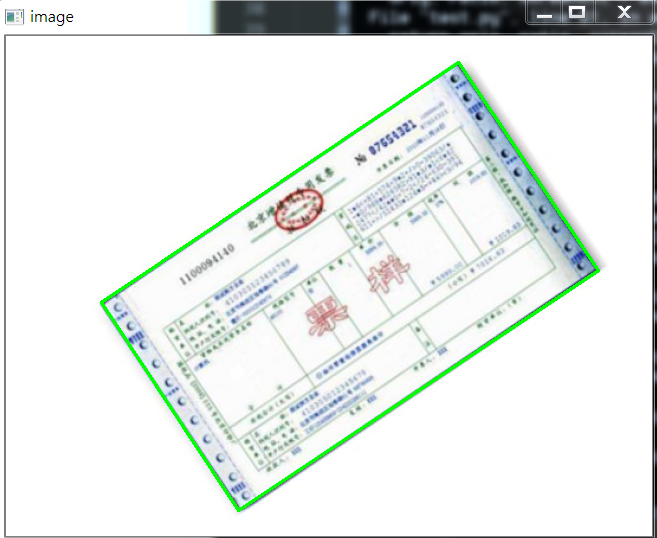
我自己更改了一下,效果一样,但是还是贴上代码:
def edge_detection(img_path):
# ********* 预处理 ****************
# 读取输入
img = cv2.imread(img_path)
# 坐标也会相同变换
ratio = img.shape[0] / 500.0
orig = img.copy()
image = resize(orig, height=500)
# 预处理
gray = cv2.cvtColor(image, cv2.COLOR_BGR2GRAY)
blur = cv2.GaussianBlur(gray, (5, 5), 0)
edged = cv2.Canny(blur, 75, 200)
# show(edged)
# ************* 轮廓检测 ****************
# 轮廓检测
contours, hierarchy = cv2.findContours(edged.copy(), cv2.RETR_LIST, cv2.CHAIN_APPROX_SIMPLE)
#cnts = sorted(contours, key=cv2.contourArea, reverse=True)[:5]
max_area = 0
myscreenCnt = []
for i in contours:
temp = cv2.contourArea(i)
if max_area < temp:
myscreenCnt = i
# res = cv2.drawContours(image, myscreenCnt, -1, (0, 255, 0), 2)
# show(res)
return orig, ratio, screenCnt
最后我们不对发票做任何处理,看原图效果:
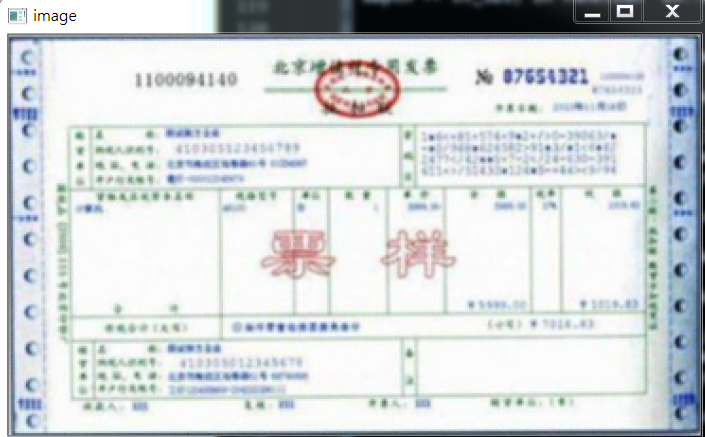
部分代码如下:
# 对透视变换结果进行处理
def get_image_processingResult():
img_path = 'images/fapiao.jpg'
orig, ratio, screenCnt = edge_detection(img_path)
# screenCnt 为四个顶点的坐标值,但是我们这里需要将图像还原,即乘以以前的比率
# 透视变换 这里我们需要将变换后的点还原到原始坐标里面
warped = four_point_transform(orig, screenCnt.reshape(4, 2)*ratio)
thresh_resize = resize(warped, height = 400)
show(thresh_resize)
return thresh
下面再看一个例子:

首先,它得到的Canny结果如下:

我们需要对它进行一些小小的处理。
我做了一些尝试,如果直接对膨胀后的图像,进行外接矩形,那么效果如下:
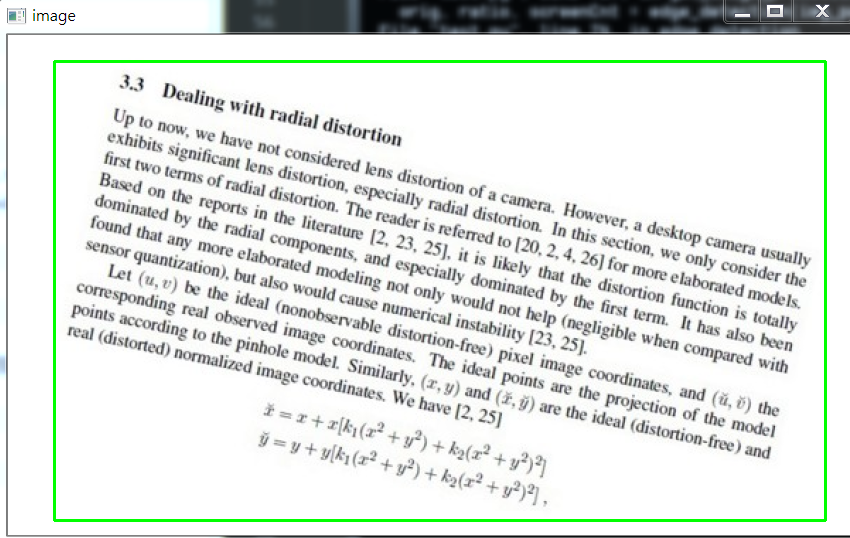
代码如下:
x, y, w, h = cv2.boundingRect(myscreenCnt)
res = cv2.rectangle(image, (x,y), (x+w,y+h), (0, 255, 0), 2)
show(res)
所以对轮廓取近似,效果稍微好点:
# 计算轮廓近似
peri = cv2.arcLength(myscreenCnt, True)
# c表示输入的点集,epsilon表示从原始轮廓到近似轮廓的最大距离,它是一个准确度参数
approx = cv2.approxPolyDP(myscreenCnt, 0.015*peri, True)
res = cv2.drawContours(image, [approx], -1, (0, 255, 0), 2)
show(res)
效果如下:
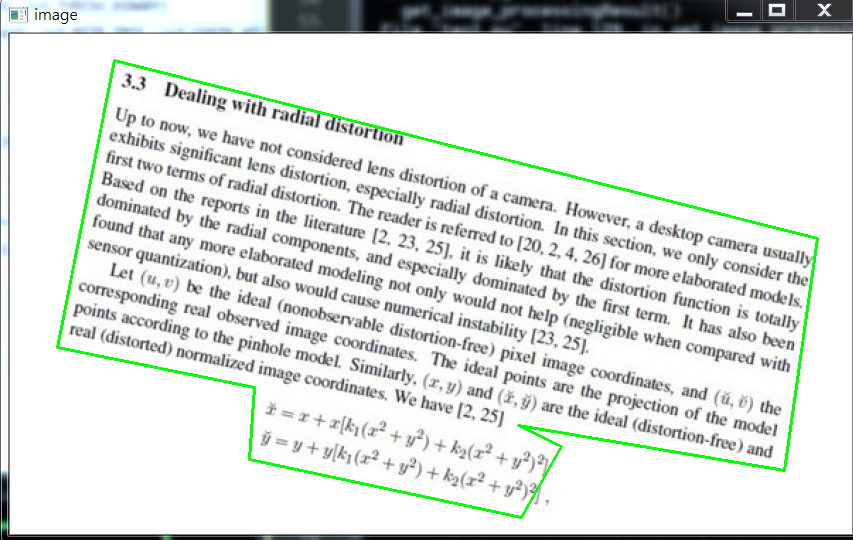
因为这个是不规整图形,所以无法进行四个角的转换,需要更多角,这里不再继续尝试。
1.3,OCR识别
这里回到我们的菜单来,我们已经得到了扫描后的结果,下面我们进行OCR文字识别。
这里使用tesseract进行识别,不懂的可以参考我之前的博客(包括安装tesseract,和通过tesseract训练自己的字库):
深入学习使用ocr算法识别图片中文字的方法
深入学习Tesseract-ocr识别中文并训练字库的方法
配置好tesseract之后(这里不再show过程,因为我已经有了),我们通过其进行文字识别。
1.3.1 通过Python使用tesseract的坑
如果直接使用Python进行OCR识别的话,会出现下面问题:
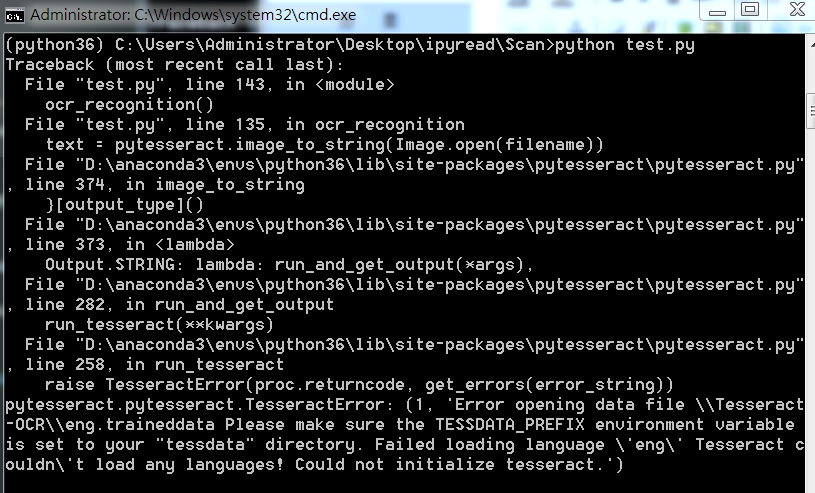
这里因为anaconda下载的 pytesseract 默认运行的tesseract.exe 是默认文件夹,所以有问题,我们改一下。
注意,找到安装地址,我们会发现有两个文件夹,我们进入上面文件夹即可

进入之后如下,我们打开 pytesseract.py。
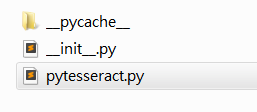
注意这里的地址:
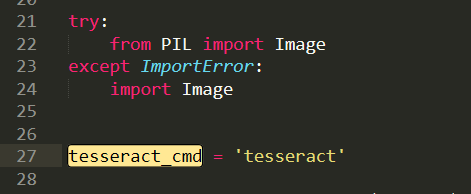
我们需要修改为我们安装的地址,即使我们之前设置了全局变量,但是Python还是不care的。
这里注意地址的话,我们通过 / 即可,不要 ,避免windows出现问题。
1.3.2 OCR识别
安装好一切之后,就可以识别了,我们这里有两种方法,一种是直接在人家的环境下运行,一种是在Python中通过安装pytesseract 库运行,效果都一样。
代码如下:
from PIL import Image
import pytesseract
import cv2
import os
preprocess = 'blur' #thresh
image = cv2.imread('scan.jpg')
gray = cv2.cvtColor(image, cv2.COLOR_BGR2GRAY)
if preprocess == "thresh":
gray = cv2.threshold(gray, 0, 255,cv2.THRESH_BINARY | cv2.THRESH_OTSU)[1]
if preprocess == "blur":
gray = cv2.medianBlur(gray, 3)
filename = "{}.png".format(os.getpid())
cv2.imwrite(filename, gray)
text = pytesseract.image_to_string(Image.open(filename))
print(text)
os.remove(filename)
cv2.imshow("Image", image)
cv2.imshow("Output", gray)
cv2.waitKey(0)
使用Python运行,效果如下:
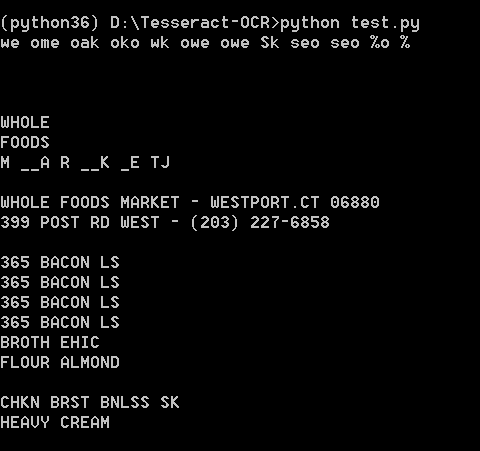
直接在tesseract.exe运行:

效果如下:

可能识别效果不是很好。不过不重要,因为图片也比较模糊,不是那么工整的。
1.4,完整代码
当然也可以去我的GitHub直接去下载。
代码如下:
import cv2
import numpy as np
from PIL import Image
import pytesseract
def show(image):
cv2.imshow('image', image)
cv2.waitKey(0)
cv2.destroyAllWindows()
def resize(image, width=None, height=None, inter=cv2.INTER_AREA):
dim = None
(h, w) = image.shape[:2]
if width is None and height is None:
return image
if width is None:
r = height / float(h)
dim = (int(w*r), height)
else:
r = width / float(w)
dim = (width, int(h*r))
resized = cv2.resize(image, dim, interpolation=inter)
return resized
def edge_detection(img_path):
# ********* 预处理 ****************
# 读取输入
img = cv2.imread(img_path)
# 坐标也会相同变换
ratio = img.shape[0] / 500.0
orig = img.copy()
image = resize(orig, height=500)
# 预处理
gray = cv2.cvtColor(image, cv2.COLOR_BGR2GRAY)
blur = cv2.GaussianBlur(gray, (5, 5), 0)
edged = cv2.Canny(blur, 75, 200)
# ************* 轮廓检测 ****************
# 轮廓检测
contours, hierarchy = cv2.findContours(edged.copy(), cv2.RETR_LIST, cv2.CHAIN_APPROX_SIMPLE)
cnts = sorted(contours, key=cv2.contourArea, reverse=True)[:5]
# 遍历轮廓
for c in cnts:
# 计算轮廓近似
peri = cv2.arcLength(c, True)
# c表示输入的点集,epsilon表示从原始轮廓到近似轮廓的最大距离,它是一个准确度参数
approx = cv2.approxPolyDP(c, 0.02*peri, True)
# 4个点的时候就拿出来
if len(approx) == 4:
screenCnt = approx
break
# res = cv2.drawContours(image, [screenCnt], -1, (0, 255, 0), 2)
# res = cv2.drawContours(image, cnts[0], -1, (0, 255, 0), 2)
# show(orig)
return orig, ratio, screenCnt
def order_points(pts):
# 一共四个坐标点
rect = np.zeros((4, 2), dtype='float32')
# 按顺序找到对应的坐标0123 分别是左上,右上,右下,左下
# 计算左上,由下
# numpy.argmax(array, axis) 用于返回一个numpy数组中最大值的索引值
s = pts.sum(axis=1) # [2815.2 1224. 2555.712 3902.112]
print(s)
rect[0] = pts[np.argmin(s)]
rect[2] = pts[np.argmax(s)]
# 计算右上和左
# np.diff() 沿着指定轴计算第N维的离散差值 后者-前者
diff = np.diff(pts, axis=1)
rect[1] = pts[np.argmin(diff)]
rect[3] = pts[np.argmax(diff)]
return rect
# 透视变换
def four_point_transform(image, pts):
# 获取输入坐标点
rect = order_points(pts)
(tl, tr, br, bl) = rect
# 计算输入的w和h的值
widthA = np.sqrt(((br[0] - bl[0])**2) + ((br[1] - bl[1])**2))
widthB = np.sqrt(((tr[0] - tl[0])**2) + ((tr[1] - tl[1])**2))
maxWidth = max(int(widthA), int(widthB))
heightA = np.sqrt(((tr[0] - br[0])**2) + ((tr[1] - br[1])**2))
heightB = np.sqrt(((tl[0] - bl[0])**2) + ((tl[1] - bl[1])**2))
maxHeight = max(int(heightA), int(heightB))
# 变化后对应坐标位置
dst = np.array([
[0, 0],
[maxWidth - 1, 0],
[maxWidth - 1, maxHeight - 1],
[0, maxHeight - 1]],
dtype='float32')
# 计算变换矩阵
M = cv2.getPerspectiveTransform(rect, dst)
warped = cv2.warpPerspective(image, M, (maxWidth, maxHeight))
# 返回变换后的结果
return warped
# 对透视变换结果进行处理
def get_image_processingResult():
img_path = 'images/receipt.jpg'
orig, ratio, screenCnt = edge_detection(img_path)
# screenCnt 为四个顶点的坐标值,但是我们这里需要将图像还原,即乘以以前的比率
# 透视变换 这里我们需要将变换后的点还原到原始坐标里面
warped = four_point_transform(orig, screenCnt.reshape(4, 2)*ratio)
# 二值处理
gray = cv2.cvtColor(warped, cv2.COLOR_BGR2GRAY)
thresh = cv2.threshold(gray, 100, 255, cv2.THRESH_BINARY)[1]
cv2.imwrite('scan.jpg', thresh)
thresh_resize = resize(thresh, height = 400)
# show(thresh_resize)
return thresh
def ocr_recognition(filename='tes.jpg'):
img = Image.open(filename)
text = pytesseract.image_to_string(img)
print(text)
if __name__ == '__main__':
# 获取矫正之后的图片
# get_image_processingResult()
# 进行OCR文字识别
ocr_recognition()
项目实战2——答题卡识别判卷
答题卡识别判卷,大家应该都不陌生。那么它需要做什么呢?肯定是将我们在答题卡上画圈圈的地方识别出来。
这是答题卡样子(原图请去我GitHub上拿:https://github.com/LeBron-Jian/ComputerVisionPractice):
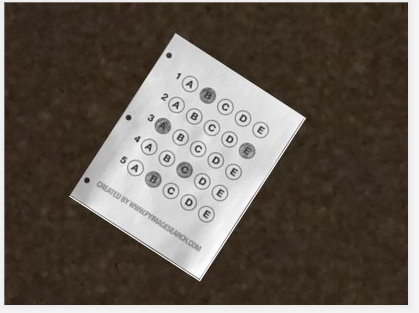
我们肯定是需要分为两步走,第一步就是和上面处理类似,拿到答题卡的最终透视变换结果,使得图片中的答题卡可以凸显出来。第二步就是根据正确答案和答题卡的答案来判断正确率。
2.1 扫描答题卡及透视变换
这里我们对答题卡进行透视变换,因为之前已经详细的学习了这一部分,这里不再赘述,只是简单记录一下流程和图像处理效果,并展示代码。
下面详细的总结处理步骤:
- 1,图像灰度化
- 2,高斯滤波处理
- 3,使用Canny算子找到图片边缘信息
- 4,寻找轮廓
- 5,找到最外层轮廓,并确定四个坐标点
- 6,根据四个坐标位置计算出变换后的四个角位置
- 7,获取变换矩阵H,得到最终变换结果
下面直接使用上面代码进行跑,首先展示Canny效果:
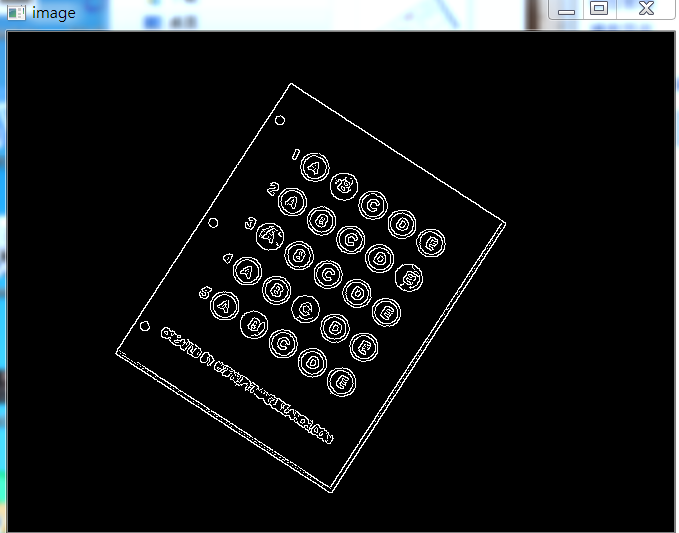
当Canny效果不错的时候,我们拿到图像的轮廓进行筛选,找到最外面的轮廓,如下图所示:

最后通过透视变换,获得答题卡的区域,如下图所示:
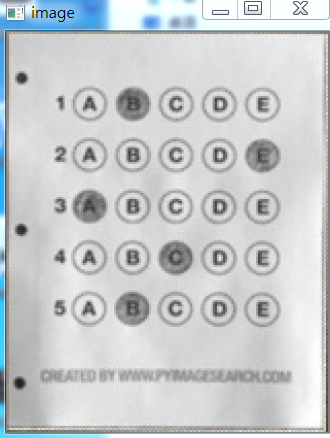
2.2 根据正确答案和图卡判断正确率
这里我们拿到上面得到的答题卡图像,然后进行操作,获取到涂的位置,然后和正确答案比较,最后获得正确率。
这里分为以下几个步骤:
- 1,对图像进行二值化,将涂了颜色的地方变为白色
- 2,对轮廓进行筛选,找到正确答案的轮廓
- 3,对轮廓从上到下进行排序
- 4,计算颜色最大值的位置和Nonezeros的值
- 5,结合正确答案计算正确率
- 6,将正确答案打印在图像上
下面开始实践:
首先对图像进行二值化,如下图所示:

如果对二值化后的图直接进行画轮廓,如下:
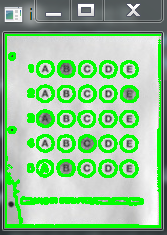
所以不能直接处理,这里我们需要做细微处理,然后拿到图像如下:

这样就可以获得其涂的轮廓,如下所示:
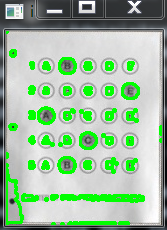
然后筛选出我们需要的涂了答题卡的位置,效果如下:

然后通过这五个坐标点,确定答题卡的位置,如下图所示:

然后根据真实答案和图中答案对比结果,我们将最终结果与圈出来答案展示在图上,如下:

此项目到此结束。
2.3 部分代码展示
完整代码可以去我的GitHub上拿(地址:https://github.com/LeBron-Jian/ComputerVisionPractice)
代码如下:
import cv2
import numpy as np
from PIL import Image
import pytesseract
def show(image):
cv2.imshow('image', image)
cv2.waitKey(0)
cv2.destroyAllWindows()
def sorted_contours(cnt, model='left-to-right'):
if model == 'top-to-bottom':
cnt = sorted(cnt, key=lambda x:cv2.boundingRect(x)[1])
elif model == 'left-to-right':
cnt = sorted(cnt, key=lambda x:cv2.boundingRect(x)[0])
return cnt
# 正确答案
ANSWER_KEY = {0:1, 1:4, 2:0, 3:3, 4:1}
def answersheet_comparison(filename='finalanswersheet.jpg'):
'''
对变换后的图像进行操作(wraped),构造mask
根据有无填涂的特性,进行位置的计算
'''
img = cv2.imread(filename)
# print(img.shape) # 156*194
gray = cv2.cvtColor(img, cv2.COLOR_BGR2GRAY)
# 对图像进行二值化操作
thresh = cv2.threshold(gray, 0, 255, cv2.THRESH_BINARY_INV | cv2.THRESH_OTSU)[1]
# show(thresh)
# 对图像进行细微处理
kernele = cv2.getStructuringElement(cv2.MORPH_ELLIPSE, ksize=(3, 3))
erode = cv2.erode(thresh, kernele)
kerneld = cv2.getStructuringElement(cv2.MORPH_ELLIPSE, ksize=(3, 3))
dilate = cv2.dilate(erode, kerneld)
# show(dilate)
# 对图像进行轮廓检测
cnts = cv2.findContours(dilate, cv2.RETR_EXTERNAL, cv2.CHAIN_APPROX_SIMPLE)[0]
# res = cv2.drawContours(img.copy(), cnts, -1, (0, 255, 0), 2)
# # show(res)
questionCnts = []
for c in cnts:
(x, y, w, h) = cv2.boundingRect(c)
arc = w/float(h)
# 根据实际情况找出合适的轮廓
if w > 8 and h > 8 and arc >= 0.7 and arc <= 1.3:
questionCnts.append(c)
# print(len(questionCnts)) # 这里总共圈出五个轮廓 分别为五个位置的轮廓
# 第四步,将轮廓进行从上到下的排序
questionCnts = sorted_contours(questionCnts, model='top-to-bottom')
correct = 0
all_length = len(questionCnts)
for i in range(len(questionCnts)):
x, y, w, h = cv2.boundingRect(questionCnts[i])
answer = round((x-32)/float(100)*5)
print(ANSWER_KEY[i])
if answer == ANSWER_KEY[i]:
correct += 1
img = cv2.drawContours(img, questionCnts[i], -1, 0, 2)
score = float(correct)/float(all_length)
print(correct, all_length, score)
cv2.putText(img, 'correct_score:%s'%score, (10, 15), cv2.FONT_HERSHEY_SIMPLEX,
0.4, 0.3)
show(img)
if __name__ == '__main__':
answersheet_comparison()
2.4 高清答题卡识别
我拿到了网上答题卡识别的原图,下面继续做一遍,按照网课的方法。
需要答题卡原图的请去我的GitHub拿,地址在文章上面。下面继续学习。
这里就省略了Canny检测边缘的步骤,也省略了获取交点的步骤,这些之前已经详细学习过了。我们这里不再赘述。
当进行完透视变换,拿到的图像如下所示:
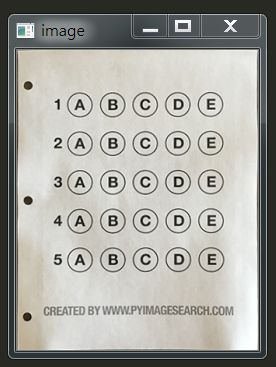
虽然背景各不相同,但是比较明显,所以扣出答题卡这一步不难。我分别将其抠出来,图像在GitHub上,我就用上图所示的样子进行下面一系列操作。
下面进行的步骤和之前答题卡识别的步骤完全不同。这里重新学习新的知识点。首先看一个函数:
2.4.1 cv2.countNonZero()函数
cv2.countNonZero()函数:返回灰度值不为0的像素数,统计黑色像素点,可用来判断图像是否全黑。
cv2.countNonZero()函数的opencv源码如下:
def countNonZero(src): # real signature unknown; restored from __doc__
"""
countNonZero(src) -> retval
. @brief Counts non-zero array elements.
.
. The function returns the number of non-zero elements in src :
. f[sum _{I: ; exttt{src} (I)
e0 } 1f]
. @param src single-channel array.
. @sa mean, meanStdDev, norm, minMaxLoc, calcCovarMatrix
"""
pass
2.4.2 根据正确答案和图卡判断正确率(图片清晰版)
这里我们首先对答题卡图片进行二值化,可以看到效果如下:
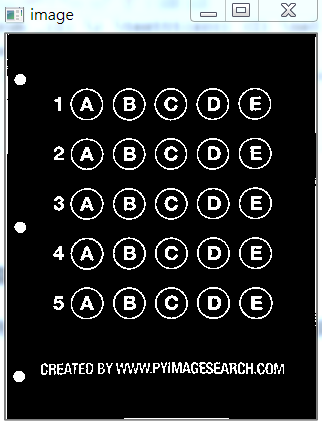
比起我们之前网上截取的图片简直是天差地别。我们再看一个涂了答题卡的图片:
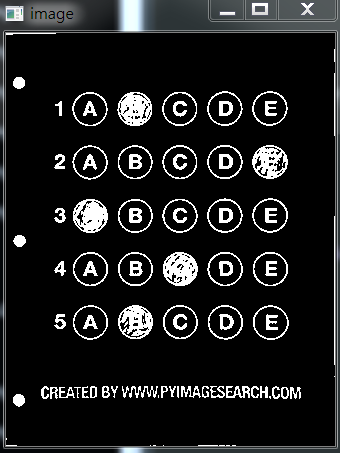
这效果是相当的好,我们不需要再对图像做其他任何处理,直接获取图像轮廓,如下:

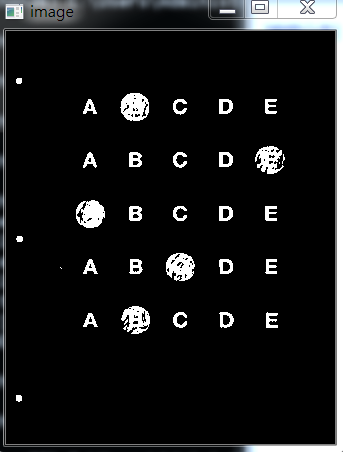
这清晰的,ABCDE都能看见。实在是夸张。。。。。
后面我们就不展示第一个图了,直接展示涂答题卡的。拿到轮廓之后,我们需要筛选出涂了答题卡的,首先我们拿到每个轮廓,我们比对一下涂了和没涂的效果,如下图所示:

最后我们对比正确答案,和上面一样,我们将正确答案标记出来,使用绿色,错误答案也标记出来,使用红色。然后展示一下。

我们发现有四个绿的(正确的),一个红的(错误的),所以得到最终准确率为80%,我们展示在答题卡上如下:
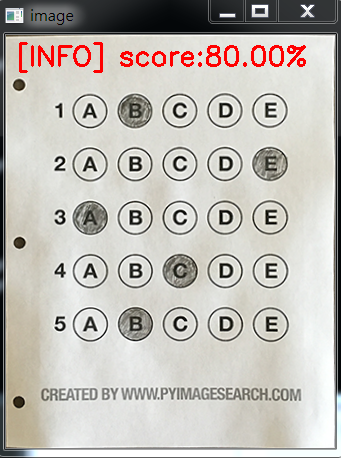
再看一个:
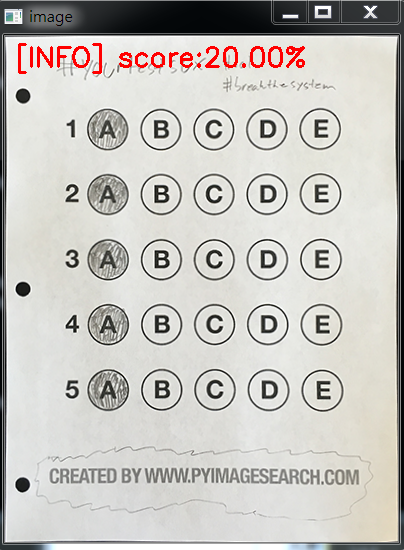
OK,标准的答题卡项目也完成了。
2.4.3 部分代码展示
需要全部代码,请去我的GitHub拿,这里展示一点重要的代码,如下:
#_*_coding:utf-8_*_
import numpy as np
import cv2
def sorted_contours(cnts, method='left-to-right'):
if method == 'top-to-bottom':
cnts = sorted(cnts, key=lambda x:cv2.boundingRect(x)[1])
elif method == 'left-to-right':
cnts = sorted(cnts, key=lambda x:cv2.boundingRect(x)[0])
return cnts
# 正确答案
ANSWER_KEY = {0:1, 1:4, 2:0, 3:3, 4:1}
def answersheet_comparison(filename):
'''
对变换后的图像进行操作(wraped),构造mask
根据有无填涂的特性,进行位置的计算
'''
img = cv2.imread(filename)
# print(img.shape)
gray = cv2.cvtColor(img, cv2.COLOR_BGR2GRAY)
thresh = cv2.threshold(gray, 0, 255,cv2.THRESH_BINARY_INV | cv2.THRESH_OTSU)[1]
# show(thresh)
thresh_Contours = thresh.copy()
# 找到每一个圆圈轮廓
cnts = cv2.findContours(thresh.copy(), cv2.RETR_EXTERNAL, cv2.CHAIN_APPROX_SIMPLE)[0]
# cv2.drawContours(thresh_Contours, cnts, -1, (0, 0, 255), 3)
# show(thresh_Contours)
questionCnts = []
# 遍历
for c in cnts:
# 计算比例和大小
(x, y, w, h) = cv2.boundingRect(c)
ar = w / float(h)
# 根据实际情况指定标准
if w>=20 and h>=20 and ar>=0.9 and ar<=1.1:
questionCnts.append(c)
# cv2.drawContours(thresh_Contours, questionCnts, -1, (0, 0, 255), 3)[0]
# show(thresh_Contours)
print('筛选出来的轮廓有: ', len(questionCnts))
# 按照从上到下进行排序
questionCnts = sorted_contours(questionCnts, method='top-to-bottom')
correct = 0
# 每排有5个选项
print('筛选出来的轮廓有: ', len(questionCnts))
for (q, i) in enumerate(np.arange(0, len(questionCnts), 5)):
# 排序
cnts = sorted_contours(questionCnts[i:i+5])
bubbled = None
# 遍历每一个结果
for (j, c) in enumerate(cnts):
# 使用mask来判断结果
mask = np.zeros(thresh.shape, dtype='uint8')
cv2.drawContours(mask, [c], -1, 255, -1) # -1 表示填充
# 通过计算非零点数量来算是否选择这个答案
mask = cv2.bitwise_and(thresh, thresh, mask=mask)
# show(mask)
total = cv2.countNonZero(mask)
# print('total is ',total) # 涂了颜色的 黑色总值很大 大于600 而没有涂的小于300
# total is 716 total is 299
# 通过阈值判断
if bubbled is None or total > bubbled[0]:
bubbled = (total, j)
# 对比正确答案
color = (0, 0, 255)
k = ANSWER_KEY[q]
# 判断正确
if k == bubbled[1]:
color = (0, 255, 0)
correct +=1
# 绘图
res = img.copy()
cv2.drawContours(res, [cnts[k]], -1, color, 3)
show(res)
# score = (correct / 5.0)*100
# print("[INFO] score: {:.2f}%".format(score))
# cv2.putText(img, "[INFO] score:{:.2f}%".format(score), (10, 30),
# cv2.FONT_HERSHEY_SIMPLEX, 0.9, (0, 0, 255), 2)
# show(img)
if __name__ == '__main__':
filename = r'test_01.png'
answersheet_comparison(filename)
参考文献:https://www.pyimagesearch.com/2014/09/01/build-kick-ass-mobile-document-scanner-just-5-minutes/
https://blog.csdn.net/weixin_30666753/article/details/99054383
https://www.cnblogs.com/my-love-is-python/archive/2004/01/13/10439224.html